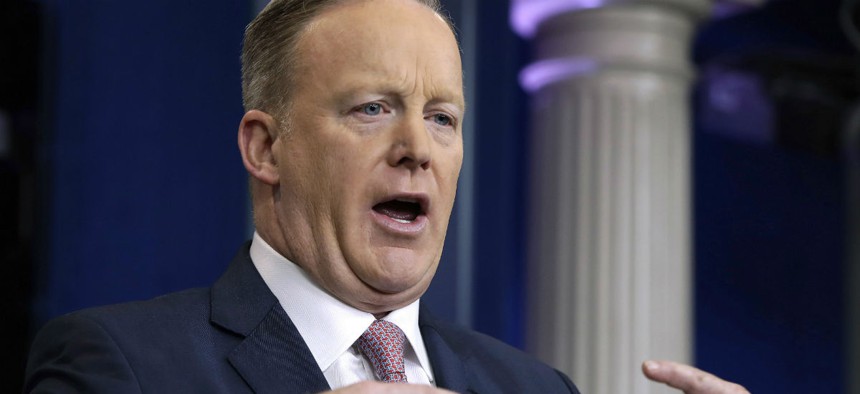
Then White House spokesman Sean Spicer described President Trump's inaugural crowds using what an administration official described as "alternative facts" in January 2017. AP file photo
Why ‘Fake News’ Matters to Feds
People are deeply mistrustful of those who develop, publicize, and use information.
President Trump views the news media as “the real enemy of the people.” This sustained campaign has deepened the wedges between those in the president’s base and those who are not. But it also matters to feds. A lot.
When wading into the debate over just how many people attended the 2017 inauguration, presidential adviser Kellyanne Conway famously pointed to “alternative facts” to support the administration’s claims of big crowds. Her formulation drew fierce attacks at the time, but there’s an important point at the bottom of the battle. People are deeply mistrustful of those who develop, publicize, and use information. There’s a suspicion that they tend to spin it, to reinforce their own prejudices and values. That made it easy for Conway to attack the National Park Service’s crowd estimates. The president’s supporters were easily convinced that the crowd estimates had been spun by the president’s opponents—and that an alternative, more favorable picture was just as valid.
It works like this: It’s possible to spin almost any fact, many people believe. If it is possible for experts to spin facts, then it’s certain that they do. If they do, then it’s impossible to believe anything is truly a fact. And if nothing is really a fact, it’s possible to build alternative conclusions based on alternative facts—and to believe that these alternatives are just as valid as the conclusions that experts originally produced.
Analysts have strongly pushed back against this line of argument, but it would be dangerous to dismiss it. There’s actually some truth in it. I once made my students very uncomfortable by taking a case study and showing them that I could put together an analysis to support any conclusion they wanted. That isn’t to say that I felt good about it, or that I believed that the facts could lead equally in different directions. But the nub of the issue is this: tell me what conclusion you want to draw and I can build a case for it.
Then there’s the business of lobbying, where special interests bring in hired guns to make their best arguments for the policy that the organization prefers. That turns out to be easier than many people think. It’s a perfectly reasonable part of the give and take of Washington politics and, in fact, it’s impossible to separate from the work of Washington politics. But with different lobbyists—indeed, with different authoritative think tanks—looking at the same problems and coming to different conclusions, it’s inevitable that everyone—policy makers, managers, members of Congress, lobbyists, and citizens—gets increasingly cynical about whether there’s anything more than self-interested spin at the bottom of most policy battles.
This has always been a challenge for those making government policy. Fake news has been around since the Romans trashed Antony’s reputation by suggesting that a queen of Egypt had compromised him. But the problem has clearly gotten worse. There’s more policy analysis in play, so there are more opportunities for spin. There are more lobbyists, so there are more hired guns running the spin cycle. There’s more instant news and social media, so it’s easier to spread information more quickly. And there’s deeper polarization, so it’s more predictable that views about facts break down along partisan lines.
This has made policymaking harder, for sure. But it’s also made it harder to be a fed, hired to figure out what’s best for the public. Government experts—some of the best minds in the known universe—have quietly confided in me that it’s getting harder for their professional judgments about important issues to stick. Does it make sense to contract out the management of a particular program? If the threat of a particular disease looms, is it possible to convince government and private companies to take big, expensive steps to stop it? What’s the best way to get a good count in the census?
It’s increasingly hard for government experts to do their jobs expertly when there’s a growing suspicion that they’re just spinning their conclusions, and that alternative conclusions might be just as valid. If you doubt just how big the problem has gotten and how much it matters, just look at the growing problem of convincing people to get flu shots and for parents to have their kids immunized.
So what’s a fed to do, especially a fed whose job it is to apply deep training, years of experience, and a tsunami of facts to help the government figure out the best way to serve citizens?
Part of the answer is to confront the basic problem: there’s almost nothing feds can say and expect others to believe just because they say it. Part of the answer is to make the analysis more robust by confronting the arguments that others might make against their best professional judgments. If saying so won’t make it so, it can be useful to figure out how to counter those whose facts are suspect. That also means figuring out how to ask better questions as well as provide better answers: what are the big issues lurking below the surface, perhaps two or three layers deep, that aren’t obvious to those swimming shallowly on the surface?
Part of the answer is for feds to get much better at communicating their conclusions. That means getting smart about data analytics and data visualization, by figuring out how to learn more from the information all around us and to paint pictures that make conclusions more convincing.
And part of the answer lies in better storytelling. People tend to remember anecdotes, not analysis. Relying on anecdotes can seem suspect to experts trained to dig deep and explore complexity. But complex statistics are typically aimed at boiling down big problems into shorthand measures, like means and medians and correlations. A story that captures the core of a problem can be just as valid—and often much more convincing.
The nub of the problem is recognizing that suspicions about “fake news” and “alternative facts” are the new and inescapable norm of political discourse—and of the federal government’s work. It’s a big and profound threat to the traditional role of expert feds. But it’s also a call for feds to get much smarter in dealing with this threat to sound policy making. And in a world that’s so full of risks and uncertainties, that’s perhaps the biggest contribution that feds can make today.







